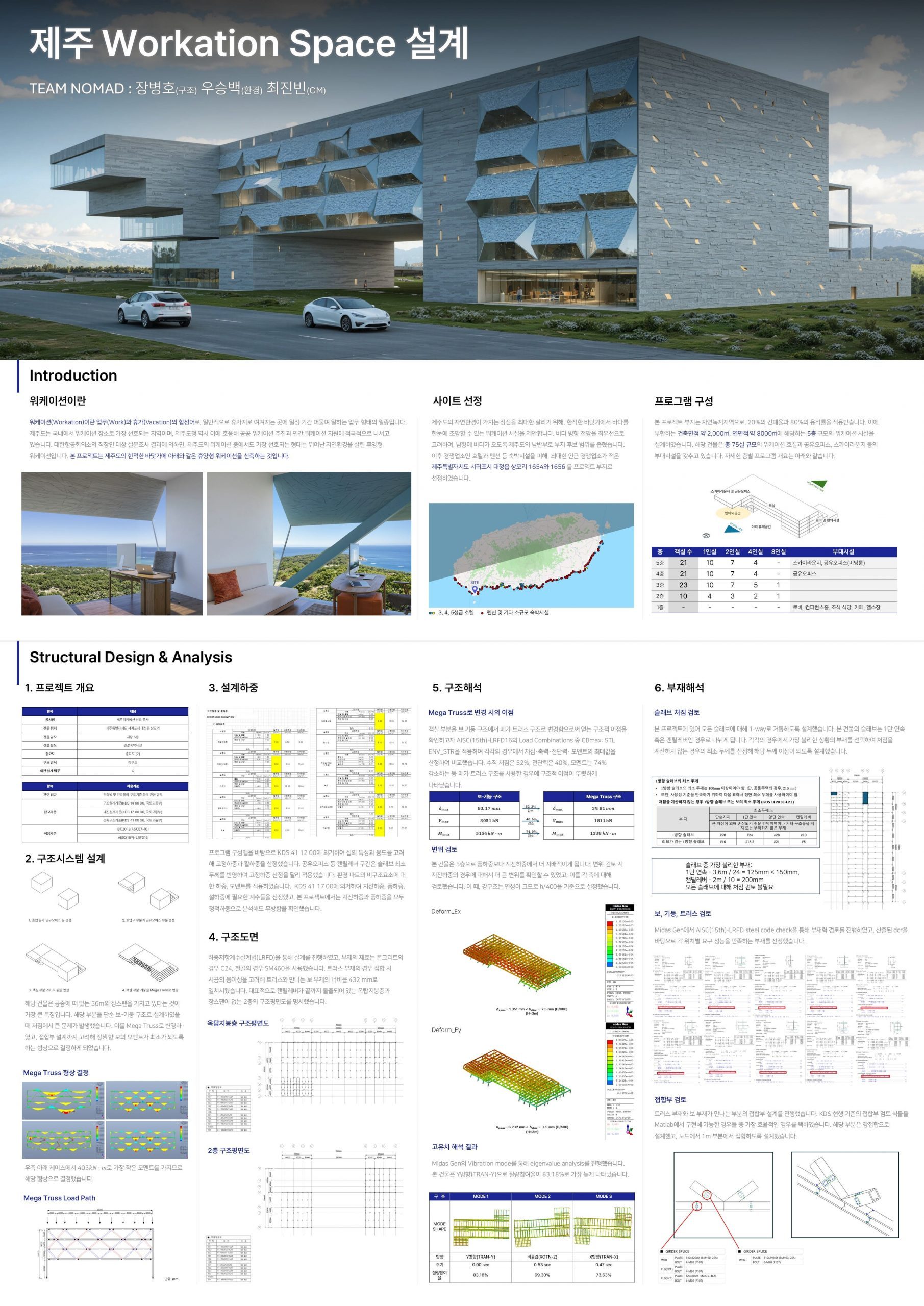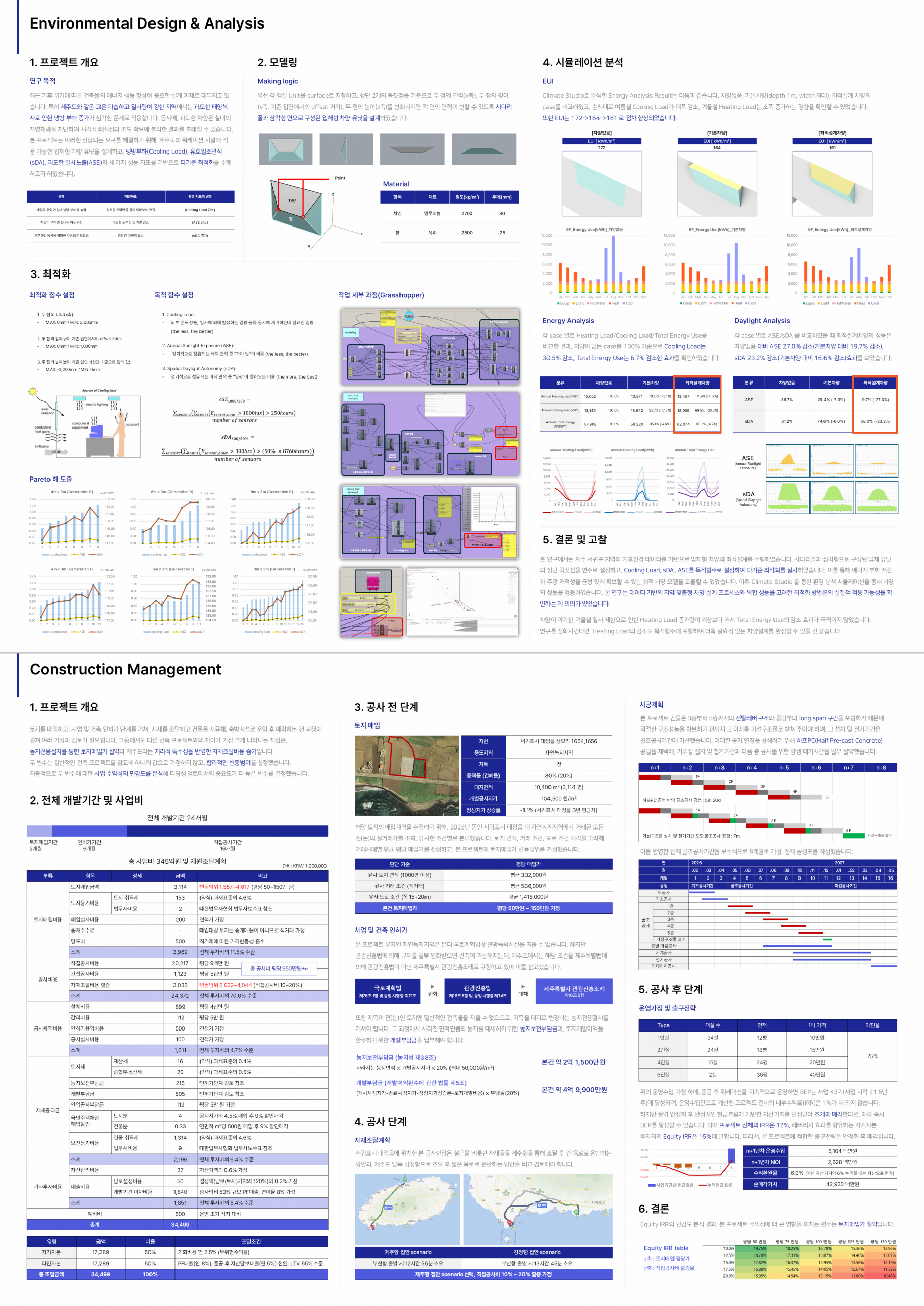노마드 (장병호, 최진빈, 우승백) _ 제주 Workation Space 설계
워케이션이란 업무(Work)와 휴가(Vacation)의 합성어로, 휴가지에 일정 기간 머물며 일하는 업무 형태를 말한다. 제주도는 국내 워케이션 중 가장 선호되는 지역이며, 그중에서도 자연 환경을 살린 휴양형 워케이션이 가장 인기가 높다. 본 프로젝트는 제주도의 한적한 바닷가에 5층 규모의 워케이션 시설을 건축하는 프로젝트이다.
구조 파트의 핵심은 장스팬 구간에 기둥 대신 메가트러스를 적용한 것이다. SM460 부재를 사용해 위치별 적정 성능을 갖는 기둥·보·트러스 부재를 설계했다. 해석 결과, 메가 트러스로 변경 시 보-기둥 구조 대비 처짐 43%, 전단력 67%, 모멘트 72% 감소를 확인하였으며, 수평 변위를 h/400 이내로 유지해 안정성을 확보했다.
제주는 고온 다습하며 강한 일사량을 지닌 지역으로 과도한 일사량와 이로 인해 발생하는 냉방 에너지 비용이 상당하다. 따라서 환경 분석에서는 이러한 제주 지역의 기후적 맥락을 반영하여, 건물 각 호실에 가해지는 해당 요소들을 감소시키는 것을 주요 목표로 설정하였으며 효율적인 차양 설계로 이를 해결하고자 했다. 입체형 차양 유닛을 설계하고 유닛의 형태를 최적화 변수로, 목적함수로는 Cooling Load, sDA, ASE를 설정하여 Grasshopper 및 Climate Studio를 활용한 시뮬레이션 분석을 통해 다목적 성능 최적화를 수행하였다.
제주도에 독창적인 워케이션 건물을 짓는 일엔 많은 장애물이 존재한다. 원하는 바다 뷰를 확보하기 위해 농지에 건물을 지어야 하며, 철골 들 일부 자재는 육지에서 배로 수송해야 한다. CM에서는 전체 사업 계획을 엑셀 모델로 구현하고, 농지 전용, 자재 해상 운송 등의 변수에 대한 사업 수익성의 민감도를 분석하고자 했다. 또한, 캔틸레버 및 장스팬 구조의 시공을 위한 가설구조물 설치 및 철거기간을 하프 PC 공법으로 상쇄하며 구체적인 공정표를 작성했다.
Project Overview: Workation Facility Development in Jeju
"Workation," a portmanteau of work and vacation, refers to a work style in which individuals perform their professional duties while staying in vacation destinations for an extended period. Among domestic locations, Jeju Island is the most favored destination for workation, particularly for resort-type facilities that leverage the island’s natural environment. This project involves the construction of a five-story workation facility on a quiet beach in Jeju.
Structural Engineering
The core of the structural design lies in the application of a mega-truss system in the long-span zones, replacing conventional columns. SM460-grade members were employed to design columns, beams, and trusses with appropriate performance levels based on their location and load requirements. Structural analysis confirmed that substituting the beam-column system with a mega-truss resulted in reductions of 43% in deflection, 67% in shear force, and 72% in moment. Lateral displacement was maintained within h/400, ensuring structural stability.
Environmental Performance
Given Jeju’s hot and humid climate and high solar radiation, excessive solar gain and resultant cooling energy costs are significant concerns. The environmental analysis focused on mitigating these climatic impacts for each unit of the building. To address this, the design incorporated optimized shading strategies. A three-dimensional shading unit was developed, using unit geometry as a design variable. Multi-objective optimization was conducted via simulations using Grasshopper and Climate Studio, with cooling load, sDA (spatial daylight autonomy), and ASE (annual sunlight exposure) set as objective functions.
Construction Management (CM)
Constructing a unique workation facility in Jeju presents several challenges. To secure the desired ocean view, construction must take place on farmland, and certain steel components must be transported from the mainland by ship. In the CM phase, a comprehensive Excel-based business model was developed to analyze project profitability sensitivity with respect to key variables such as farmland conversion and maritime logistics. Additionally, the construction and removal of temporary structures required for cantilever and long-span systems were offset using the half-PC (precast concrete) method, and a detailed construction schedule was established accordingly.

